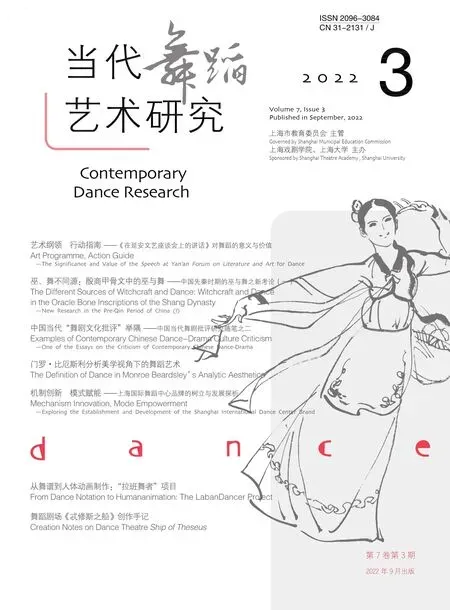An Ecological Interpretation of the Elephant Foot Drum Dance of Dai People in Jinggu County, Yunnan
Liu Li Yan Erzhuan
【Abstract】 Jinggu is a scenery mountain county located in the southwest of Yunnan Province.As an epitome of the intangible cultural heritage under the category of dance in Yunnan, the Elephant Foot Drum Dance of Dai People in Jinggu remains a carrier to disseminate the historical experience and cultural memory of Dai People in Jinggu.This essay, from the perspective of choreoecology, extracts the typical choreme factors of the Elephant Foot Drum Dance, expounds the derivatives of the ecological niche and ecological range of this dance due to the transformation of time and region, and analyzes the choreoecological system of this multilayered and multi-dimensional dance.
【Keywords】 Jinggu County, Dai People, Elephant Foot Drum Dance, choreme, ecological niche, ecological range.
The Dai ethnic group is a nationality that has been inhabiting Yunnan Province since ancient times.It was in as early as the 1st century B.C.that Dai ancients had been recorded in the literature of the Han Dynasty,since then, the Dais have been given multiple names including Dianyue, ShanTan, Heichi, Jinchi, Yinchi,Xiujiao and Baiyi.After the founding of the People’s Republic of China, this ethnic group, with respect to the wishes of its people, was collectively named “Dai”.Dai is a transborder nationality and it shares profound historical and ethnical relations with the Shan (Dai)people in Burma, the Lao people in Laos, the Tai people in Thailand as well as the Ahom people in Assam, India.The Dai people mainly reside in Xishuangbanna Dai Autonomous Prefecture, Dehong Dai as well as Jingpo Autonomous Prefecture and Pu’er in Yunnan Province.Due to the disparities in the ecological environment led by the wide distribution of Dai people, the performing forms and aesthetic styles of the Dai dances vary to a certain degree among different regions.
Ⅰ.The Ecological Environment of Jinggu County and the Features of Dai Dances
Situated in southwestern Yunnan Province, Jinggu Dai and Yi Autonomous County in Pu’er is dominated by mountains and plateaus with landscapes of valleys.The county is known as the “The Pearl of the Forest,The Home of Mango and The Holy Land of Buddhism”.Different ethnic groups have been residing in Jinggu for generations, including Dai, Yi, Lahu, Hani, Hui, Blang,Han, and others.Among them, Dai and Yi have the largest population.Various Buddhist halls or temples for local gods can be frequently seen in the county, which honor Buddhism, Taoism and local gods.Worship is common among the locals, and various cultures converge here.Dai people in Jinggu County are mainly engaged in agriculture and thus have formed an ecological perspective of rice cultivation in the agricultural civilization from an early stage.Their language belongs to the Dai branch of the Zhuang-Dong group of the Sino-Tibetan language family, and the people mostly use Chinese when communicating with other ethnic groups.The cultural features of the literature, architecture,clothing, music and dancing of the Dai ethnic group bear their ethnic characteristics that came into being naturally since ancient times, as well as the cultural ecological traits of the communication between Dai and Han ethnic groups, South and North cultures and Chinese and foreign cultures.Dances of the Dai nationality are the most significant cultural node of the Dai nationality in Jinggu County as it doesn’t only reflect the historic cultural evolution of them, but also showcases the ethnic wisdom and cultural memory in changing yet recognition.
The main folk natural dances of the Dai people in Jinggu County comprise the Elephant Foot Drum Dance,White Elephant Dance, Great Drum Dance, Gao Sheng Dance, Peacock Dance and Dance of Tang Monk’s Pilgrimage, which are mostly performed for rituals and entertainment or to pray for a good harvest.As the Dai people are widely distributed in Yunnan province, their geographical isolation has led to cultural separation.In the process of genealogical differentiation of the Dai folk dances, influenced by other neighboring ethnic groups, the contents and forms of Dai Dances have diversified; Nonetheless, they have inherited the formal characteristics of the Dai traditional dances, such as the downward movements of body on the downbeats, the emphasis on dancing steps, the pair dancing in circles,giving the dance a jovial and spontaneous feature,exhibiting simultaneously external singularity and relative stability of the internal factors.
Ⅱ.The Analysis of Choremes of the Dai People’s Elephant Foot Drum Dance in Jinggu
Elephant Foot Drum Dance, also called Guangheila,Guangwujie or Guangtuo in the Dai language, was named after the dancer carrying an elephant-footshaped drum.Li Sicong of the Ming Dynasty, writes in hisEncyclopedic Records of Yunnan, Biographies of the Hundred Barbarians, “The Cheli people compose their own music.They made drums of 3 to 5chiwith sheepskin and beat them with hands, which are performed together with copper cymbals, copper drums and clappers when there’s a feast in the village, the big drums andlushengare played while people dance for fun”.“Cheli”refers to the areas of today’s Xishuangbanna, Simao,Pu’er and Yuanjiang.The “drums of 3 to 5chi” is the elephant foot drum that is widely performed in today’s ethnic groups of Dai, Jingpo, De’ang, Jino, Achang,Lahu, Blang, Va, and so on.①LI L.Cultural Study of Yunnan Folk Dance[M].Shanghai:Shanghai Music Publishing House,2020:189.
The Elephant Foot Drum Dance exists widely in Xishuangbanna Prefecture, Dehong Prefecture, and Jinggu County and Menglian County in Pu’er, as well as Cangyuan County and Gengma County in Lincang area.It is the most distinctive male folk dance of the Dai people.As early as 2008, the Elephant Foot Drum Dance of Xishuangbanna Dai Autonomous Prefecture was included in the National Intangible Cultural Heritage List.In 2013, the dance of Jinggu County was collected in the Intangible Cultural Heritage List of Yunnan Province and was highly reputed, as the proverb says: “Ansai Waist Drum in the north, Jinggu Elephant Drum Dance in the south.” Various forms of the dance in different regions manifest the ecological influence of the environment on the dance language system, which is mainly represented in the transformation of the choreme factors and their ecological niche and range.
“Choreme is the dancing movement induced from the expressing function of dance, a cluster of dancing movements with the same ideographic and aesthetic feature that could be directly perceived”①ZI H Y,WANG N.Choreoecology[M].Beijing:Culture Art Publishing House,2012:92..The typical choreme factors of the Elephant Foot Drum Dance of Dai people in Jinggu could be categorized in Table 1.
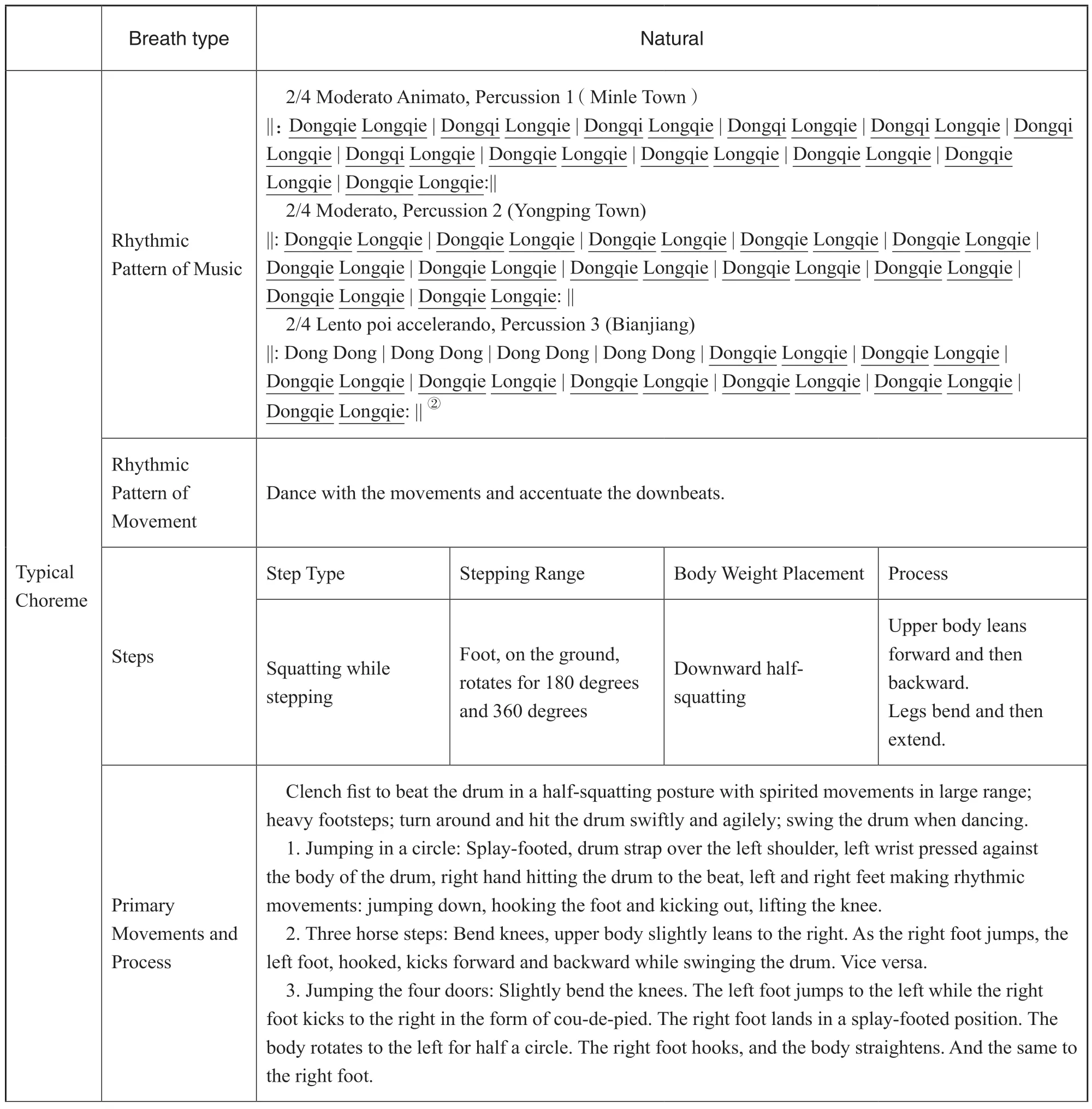
Table 1 The typical choreme factors of the Elephant Foot Drum Dance of Dai people in Jinggu
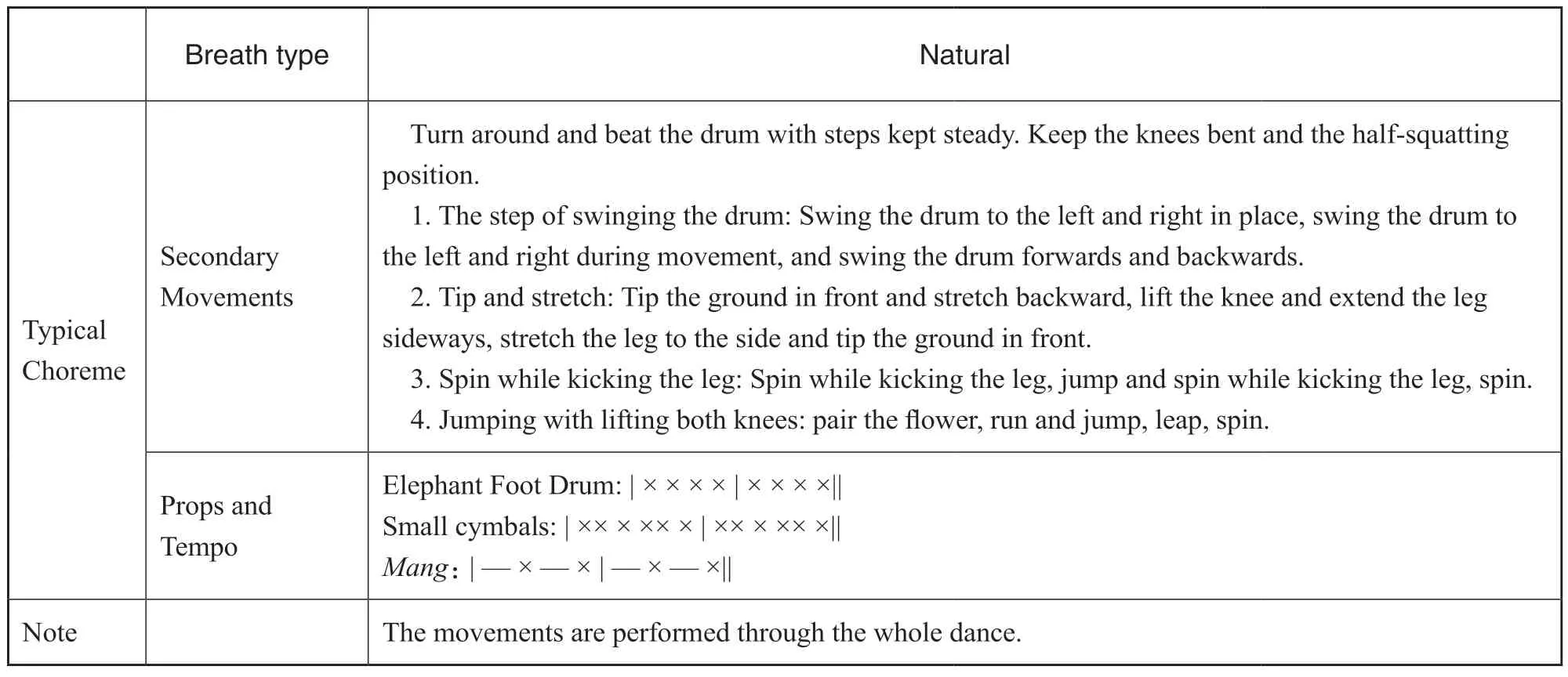
续 表
As shown in Table 1, the Elephant Foot Drum Dance of the Dai people in Jinggu is rather unique in style,the dancers of which, with natural breath, highlight the movements of “squatting” in the quadruple rhythm with body weight downward.The most distinctive feature of the Elephant Foot Drum Dance in Jinggu is that the dancers here kick legs to the side while drawing back their hips, while the dancers in Xishuangbanna and other areas kick legs while extending their hips.The female dancers of Elephant Foot Drum Dance perform with more tenderness, with the intention of praying for a good harvest and good luck.
The main ecological factors that have influenced the development of the Elephant Foot Drum Dance include:
1.Religion — Theravada Buddhism
Known as “the holy land for Buddhist traces”,Jinggu remains home to over 20 Buddhist traces, each having a touching story of Buddhism (Fig.1).The Dai people in Jinggu believe in spiritualism and worship the spirits of nature in various ways at different festivals,praying for blessing, warding off calamities and wishing for good luck.Most of the natural dances in Jinggu are performed at religious ceremonies.For example,in the unique Dai ritual of Danbada in Jinggu, people will perform the Elephant Foot Drum Dance, the White Elephant Dance, the Gaguang Dance and the Sparkle Dance.Under religious influences, these dances are more conservative compared to those in other Dai regions.
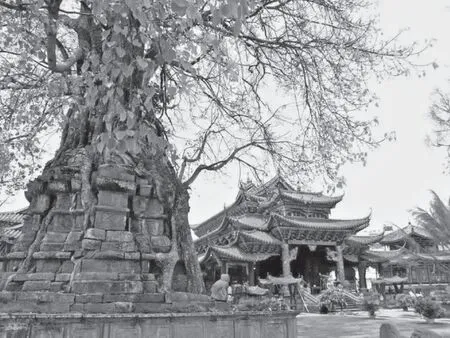
Fig.1 Mengwo Buddha Temple①
2.Festivals and Ceremonies — Water-Splashing Festival and Offerings to the White Elephant
Jinggu remains one of the traditionally crucial places for the spread of Theravada Buddhism in China.Traditional festivals of the Dai people include the Water-Splashing Festival, Door Closing Festival, Door Opening Festival and New Rice Festival (Fig.2).During these festivals,people worship gods and Buddha every year according to traditional customs.As people pick the flowers, stack the sand, conduct the bathing ceremony and splash water, they dance the Elephant Foot Drum Dance, which is of vivid ethnic features feature and mass character.Apart from the native festivals, the Dai people also celebrate festivals of other ethnic groups, such as Spring Festival, Tomb-Sweeping Day, Dragon Boat Festival, Lantern Festival,Mid-Autumn Festival, predominantly celebrated by the Han.During the celebrations, people play the elephant foot drum and perform the Elephant Foot Drum Dance to entertain both themselves and others, vividly manifesting the uniqueness and mass participation of these festivals.For example, during the Dai New Year, and the Water-Splashing Festival, people wish each other good luck, happiness, and health by splashing water onto each other.The celebration is led by white elephants followed by the Elephant Foot Drum Dance team performing on the streets.The dancing changes with the drumbeats, forming a rather spectacular scene.
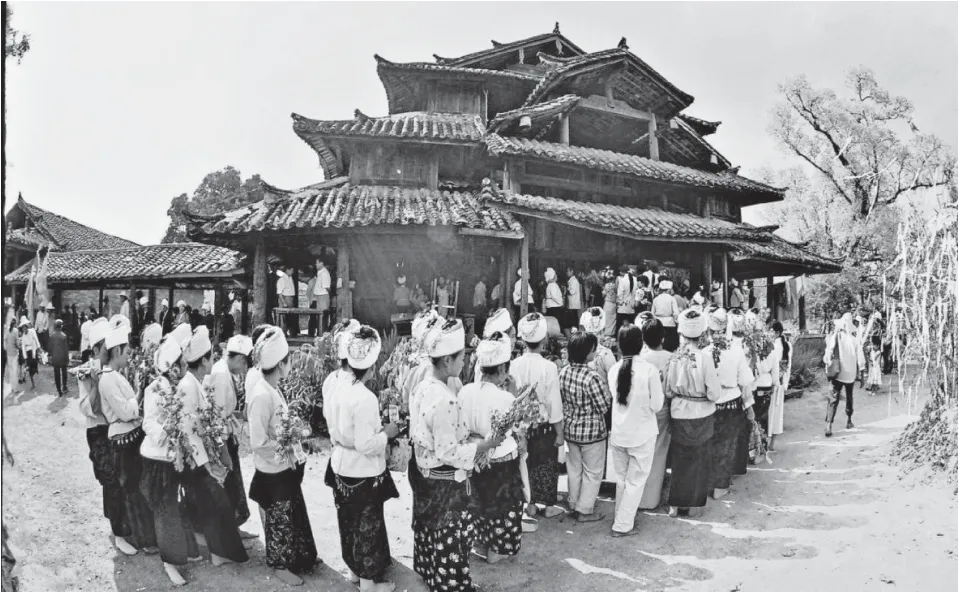
Fig.2 The “Dan Bada” Ritual of Dai People in Jinggu①
3.The Prop — The Elephant Foot Drum
The elephant foot drum of Dai people serves both as a prop and a musical instrument.As a prop, it is used together along with Mang, gong, small cymbal and other instruments.People dance while beating the drum.As an instrument, people put the drum strap over the left shoulder with the drum inclined in front of the body or standing on the ground.The drum is mainly beaten with the right hand.There are various ways of beating, as it can be performed by finger, palm, fist, or elbow.The sound of it can be vigorous and mellow.
The elephant foot drum is usually of three sizes: the long drum with a length of about 1.7 meters, the middle-sized of 1 meter, and the short of 0.7 meters.The middle-sized drum is most used by the Dai people of Jinggu, who combined the drum beat with their movements to imitate a peacock’s gestures such as spreading the tail and competing in beauty contests with other peacocks.The dance also incorporates certain elements from the Dai martial arts.The dancers kick the leg, hook the feet, stamp the ground, swing the hip and spin to the beat of the drum, displaying quite unique postures (Figs.3 and 4) .Female dancers in Jinggu tend to use the short drum,for their movements contain numerous jumps and thus require more flexibility, highlighting the performance itself as well as its athletic nature.
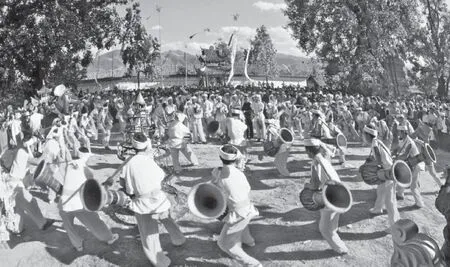
Fig.3 The “Elephant Foot Drum Dance” during “The Water Splashing Festival” in Jinggu②

Fig.4 The “Elephant Foot Drum Dance” of the “Dan Bada” ritual in Jinggu③
Ⅲ.The Ecological Niche and Ecological Range of the Elephant Foot Drum Dance
The subject of choreoecology is “Natural Dance”,related concepts of which consist of “Primal Dance”,Quasi-natural Dance and “Primal Dancers’Dance”.The“Primal Dance” is influenced by the changes of time and place, but the changed dance can still preserve the main characteristics of the original dance.The Quasi-natural Dance absorbs external elements to varying degrees,so that it is no longer pure natural dance.But they still have not become artificially created dances.The Original Dance by Folk Artists inherits and develops natural dances and their variants.For instance, an outstanding dancing artist, who performs with highly advanced primal dancing skills under certain circumstances, could be regarded as a “Folk Artist”, and his or her dance is“Original Dance by Folk Artists”.The coexistence of these three natural dances could be found in the variation of the ecological niche of dance.
“Ecological niche is the synthesis of environmental factors and dance, in which mutual influences and effects happen.The difference of ecological niche leads to the disparity in the degree that different dances adapt to the environment”①ZI H Y,WANG N.Choreoecology[M].Beijing:Culture Art Publishing House,2012:147..The transformation of ecological niche can directly or indirectly (progressively or eruptively)have influences on the morphological characteristics and the cultural functions of the Elephant Foot Drum Dance.
1.The Ecological Niche among Folks,Stages and Schools
Hailed as “the valley of a thousand sceneries”,Jinggu County served as “the key stop of the ancient road of tea and salt” in southwest China historically.Based on its rich natural resources and folk cultural resources,as well as its unique healthy altitude, Jinggu County has been creating new business forms, resulting in the boost of the ecological niche’s changes of the dance of the Dai nationality in Jinggu County.At the early stage of the Dai music and dance, the ecological niches of the Elephant Foot Drum Dance existed mostly among the people and the dance was mainly inherited by the elders’teaching.Most people learned and inherited the dance for the purpose of self-entertainment.In the past, every year when Jinggu County celebrated the Water-Splashing Festival or other festivals, there would be an Elephant Foot Drum Dance performance by a team composed of a hundred dancers, forming quite an overwhelming and grand view (Fig.5).The dance under this ecological niche is the “Primal Dance” that retains the function and form of the original dance.
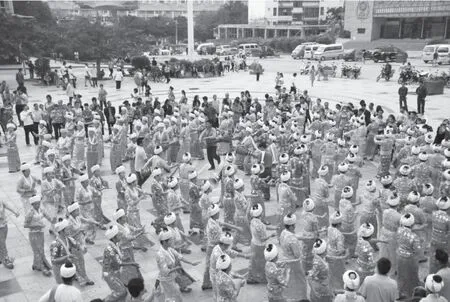
Fig.5 The female “Elephant Foot Drum Dance” during the celebration ofWater Splashing Festiva②
The emerging trend of protecting intangible cultural heritage has led to the extension of the ecological niches and range of the Elephant Foot Drum Dance in Jinggu.In the past, the inheritance of the traditional dances of the Dai people was rather local and within villages.Now it has transformed to being promoted by local people,governments and schools and more units together.Firstly,the stage performance of the dance has resulted in certain modifications.In “The 10th Ethnic & Folk Song, Dance and Music Exhibition and Performance of Yunnan Province”, the programme from Jinggu County was“The Style and Charm of the Drum”.The choreography incorporates certain dancing movements including“peacock hatching eggs”, “contending beauty between two males”, “jumping the four doors” and “three horse steps” of Yongping Town, Weiyuan Town, and Mengban Village of Jinggu County.The dance “is influenced by professional dancers as they remake it, yet it has not hence become contrived.Thus, it is still a ‘Quasi-natural Dance’ with ethnic and folk features”①ZI H Y,WANG N.Choreoecology[M].Beijing:Culture Art Publishing House,2012:45..Secondly, the campaign “Bringing Intangible Cultural Heritage into Schools” has also popularized and simplified the dance.Since 2017, the 2nd Elementary School of Jinggu County has been inviting key teachers from the local cultural center or inheritors of the intangible cultural heritage culture to teach dances like the Elephant Foot Drum Dance and the Gaguang dance through the channel of The School Education of National Unity and Progress.When taught in schools, the movements of the legs in the dance have been simplified to facilitate teaching, and the circling dance has been substituted with pair dance and group dance, making it both good for the health and pleasant to watch.Nowadays, the sound of the Elephant Foot Drum is echoing in the lives of Jinggu people as well as on stages and at schools.The diversity of the ecological niches has rejuvenated this ancient folk dance in this beautiful mountain town.
2.The Ecological Range of Adaptation,Sharing and Development
“Ecologically speaking, the degree that creatures are able to adapt to the environment is termed ecological range”②ZI H Y,WANG N.Choreoecology[M].Beijing:Culture Art Publishing House,2012:148..The transformation of the ecological niche of the Elephant Foot Drum Dance during its development proves that the dance has a rather high ecological range.Through all the social changes and impacts of external factors, it has not lost its internal cultural features and its traditional form remains relatively intact.The explanation of its great ecological range is as follows.Firstly, the Elephant Foot Drum Dance is rooted in the people.Meanwhile, it also requires certain skills and is pleasing to watch.Secondly, this popular form of dance has gradually developed into a means of life, and there emerges professional folk artists with advanced skills.Feng Zhengliang, a villager in Mangxian Village of Jinggu County, is renowned as “The King of Drum”among the Jinggu people.Due to the fact that a large number of young men migrated into urban areas, Feng,as a folk artist, started to establish a female Elephant Foot Drum Dance team, which was later invited to perform on a noncommercial show of ethnic costume — The Culture Wore on the Body, which was held in the Lake Mirror Space of 798 Art Zone in Beijing.The audience were stunned by their splendid performance.The drum was beat by palm with an intricacy of hand movements.The hip swung as the leg kicked, making it even more graceful.It is precisely the conscious inheritance and innovation of those folk artists that make the Elephant Foot Drum Dance of the Dai people in Jinggu County continue to develop innovatively during its progress of adapting to ecological environment and sharing traditional cultures.Thanks to their efforts, the dance has become a significant link to maintain the national cultural identity of the Dai people.
Choreoecology calls for a holistic and comprehensive perspective toward folk dances and consciously enhancing the ecological awareness of folk dances so as to constantly optimize cultural ecology and promote the steady development of the dance profession.Historically, the 26 ethnic groups in Jinggu County have been constantly communicating and exchanging culturally, during which,an ecological pattern of the coexistence of multiple ethnic cultures has come into being as the Dai people keep absorbing and accommodating cultures of neighboring ethnic groups.Because of the voluntary choice and the active creation of the Dai people, the ecological niche and range of the Elephant Foot Drum Dance in Jinggu County has evolved and will continually grow towards a broader direction, constituting a multi-layered and multidimensional dance ecological system.

